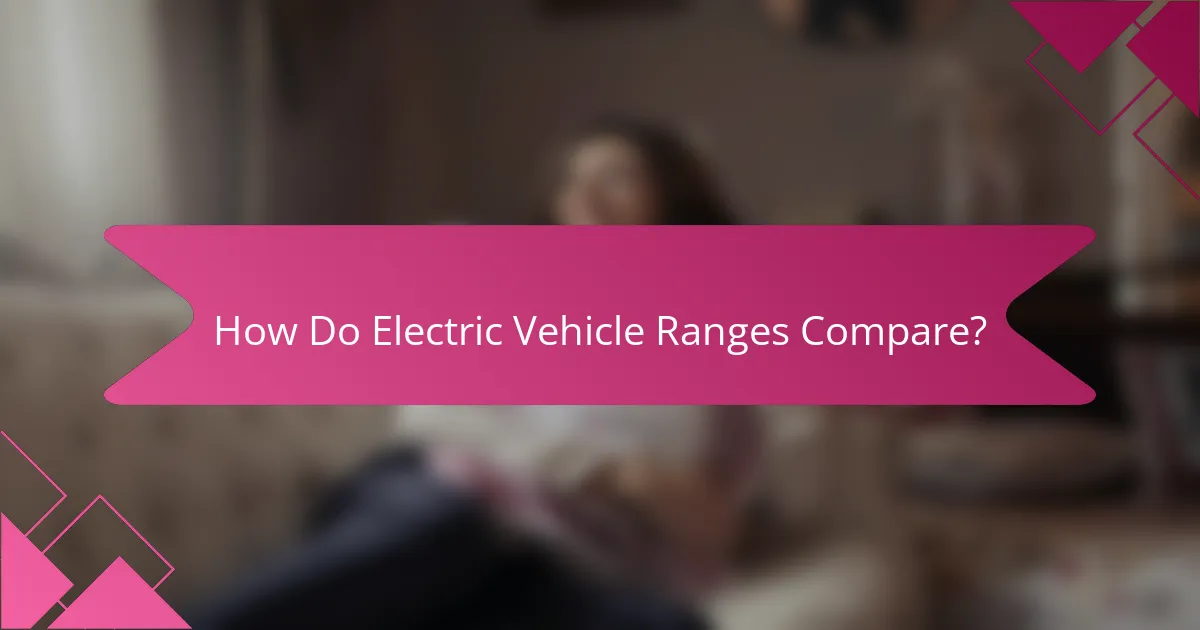As electric vehicles (EVs) continue to gain popularity in 2023, they present a range of eco-conscious options that cater to diverse preferences and budgets. Key models like the Tesla Model 3, Ford Mustang Mach-E, and Chevrolet Bolt EV not only prioritize sustainability but also offer varying ranges and advanced features that enhance the driving experience. Understanding these aspects is essential for consumers looking to make informed choices about their next vehicle.

What Are the Best Electric Vehicles in 2023?
The best electric vehicles (EVs) in 2023 offer a combination of range, features, and eco-conscious design. Key models include the Tesla Model 3, Ford Mustang Mach-E, Chevrolet Bolt EV, Nissan Leaf, and Rivian R1T, each catering to different preferences and budgets.
Tesla Model 3
The Tesla Model 3 is renowned for its impressive range, often exceeding 350 miles on a single charge, depending on the variant. It features advanced technology, including Autopilot capabilities and a minimalist interior design that emphasizes a large touchscreen interface.
Consider the Model 3 if you prioritize performance and cutting-edge technology. Its fast charging network allows for convenient long-distance travel, but be aware of potential wait times at busy Supercharger stations.
Ford Mustang Mach-E
The Ford Mustang Mach-E combines the iconic Mustang branding with electric performance, offering a range of around 300 miles. Its spacious interior and cargo capacity make it a practical choice for families, while its sporty handling appeals to driving enthusiasts.
When evaluating the Mach-E, note its various configurations, including rear-wheel and all-wheel drive options. This flexibility allows buyers to choose a model that best suits their driving style and needs.
Chevrolet Bolt EV
The Chevrolet Bolt EV is an affordable option with a range of approximately 250 miles, making it suitable for daily commuting and city driving. Its compact size and efficient design contribute to easy maneuverability and parking in urban settings.
Consider the Bolt EV if you’re looking for a budget-friendly electric vehicle without sacrificing range. It’s also eligible for federal tax credits, which can further reduce the overall cost.
Nissan Leaf
The Nissan Leaf has been a staple in the electric vehicle market for years, offering a range of around 150 to 226 miles, depending on the battery option. Its user-friendly technology and comfortable ride make it a solid choice for first-time EV buyers.
When choosing the Leaf, consider its affordability and the availability of various trims. While it may not have the longest range, it excels in practicality and ease of use for everyday driving.
Rivian R1T
The Rivian R1T is an innovative electric pickup truck that stands out with its rugged design and off-road capabilities. It offers a range of up to 400 miles and features a spacious interior with advanced technology tailored for adventure seekers.
If you need a versatile vehicle for both work and play, the R1T is worth considering. Its unique features, such as a gear tunnel for extra storage, cater to outdoor enthusiasts, but keep in mind that its price point is higher than many traditional EVs.

How Do Electric Vehicle Ranges Compare?
Electric vehicle ranges vary significantly among different models, affecting their usability and appeal. Understanding these ranges helps consumers choose the right electric vehicle based on their driving needs and lifestyle.
Average range of Tesla models
Tesla models are known for their impressive electric ranges, often exceeding 300 miles on a single charge. For instance, the Model S can achieve around 370 miles, while the Model 3 typically offers between 250 to 350 miles depending on the variant.
Factors influencing Tesla’s range include battery capacity, aerodynamics, and driving conditions. Tesla’s extensive Supercharger network also enhances the practicality of longer trips, allowing for convenient recharging along popular routes.
Ford Mustang Mach-E range
The Ford Mustang Mach-E offers a competitive range, with estimates ranging from about 230 to 300 miles depending on the battery pack and drivetrain configuration. The standard range model provides around 230 miles, while the extended range version can reach up to 300 miles.
Driving habits and environmental conditions can affect the Mach-E’s range. Additionally, the vehicle supports fast charging, which can replenish a significant portion of the battery in a short amount of time, making it suitable for longer journeys.
Chevrolet Bolt EV range
The Chevrolet Bolt EV is recognized for its affordability and practical range, typically around 250 miles on a full charge. This makes it a viable option for daily commuting and moderate road trips.
Charging infrastructure is crucial for maximizing the Bolt EV’s potential. Home charging solutions can provide overnight replenishment, while public charging stations can help extend its usability for longer distances. The Bolt EV’s efficiency makes it a strong contender in the electric vehicle market.

What Features Should You Look for in an Electric Vehicle?
When choosing an electric vehicle (EV), focus on battery capacity, charging options, safety ratings, and infotainment systems. These features significantly impact your driving experience, convenience, and overall satisfaction with the vehicle.
Battery capacity
Battery capacity is a critical factor that determines how far an electric vehicle can travel on a single charge. Measured in kilowatt-hours (kWh), a higher capacity typically means a longer range, with many modern EVs offering between 50 kWh to 100 kWh. Consider your daily driving needs to select an appropriate capacity.
For example, if you often drive short distances, a vehicle with a lower capacity may suffice. However, if you plan longer trips, aim for a model with a larger battery to minimize range anxiety.
Charging options
Charging options vary widely among electric vehicles and can significantly affect your convenience. Look for vehicles that support both home charging and public charging stations. Level 2 home chargers can fully charge most EVs overnight, while DC fast chargers can provide substantial range in under an hour.
Check the availability of charging stations in your area and along your typical routes. Some EVs come with charging networks offering benefits like free charging for a limited time, which can enhance your ownership experience.
Safety ratings
Safety ratings are essential when evaluating electric vehicles, as they reflect how well a car protects its occupants in a crash. Look for vehicles that have received high marks from organizations like the National Highway Traffic Safety Administration (NHTSA) or the Insurance Institute for Highway Safety (IIHS).
Many EVs are built with advanced safety features, such as automatic emergency braking and lane-keeping assist. Prioritize models that include these technologies for added peace of mind.
Infotainment systems
The infotainment system in an electric vehicle can enhance your driving experience by providing navigation, entertainment, and connectivity features. Look for systems that support smartphone integration through Apple CarPlay or Android Auto, allowing seamless access to your apps.
Consider the user interface and responsiveness of the infotainment system, as well as the availability of features like voice recognition and over-the-air updates. A well-designed system can make your daily drives more enjoyable and efficient.

What Are the Environmental Benefits of Electric Vehicles?
Electric vehicles (EVs) offer significant environmental benefits by reducing greenhouse gas emissions and minimizing air pollution. Their operation relies on electricity, which can be generated from renewable sources, further enhancing their eco-friendliness compared to traditional gasoline or diesel vehicles.
Reduced carbon emissions
Electric vehicles contribute to lower carbon emissions by eliminating tailpipe emissions entirely. While the production of electricity can still generate emissions, the overall lifecycle emissions of EVs are generally much lower than those of internal combustion engine vehicles, especially when powered by renewable energy sources.
For instance, studies suggest that EVs can produce up to 50% less carbon dioxide over their lifetime compared to conventional cars. This reduction is particularly impactful in urban areas where vehicle density is high.
Lower air pollution
By operating without tailpipe emissions, electric vehicles significantly reduce air pollutants such as nitrogen oxides and particulate matter. This leads to improved air quality, which is crucial for public health, especially in densely populated cities.
Transitioning to EVs can help lower the incidence of respiratory diseases and other health issues linked to air pollution. For example, cities that have adopted electric public transport systems report noticeable improvements in air quality metrics.
Energy efficiency
Electric vehicles are typically more energy-efficient than traditional vehicles, converting a higher percentage of electrical energy from the grid to power at the wheels. While gasoline vehicles convert about 20% of the energy stored in gasoline, EVs can convert over 60% of the electrical energy from the grid.
This efficiency not only translates to lower energy costs for consumers but also means that less energy is wasted, making EVs a more sustainable choice. As battery technology continues to improve, the energy efficiency of electric vehicles is expected to increase even further.

How Do Electric Vehicle Incentives Work in the US?
Electric vehicle (EV) incentives in the US are financial benefits designed to encourage the purchase and use of electric cars. These incentives can include tax credits, rebates, and grants, which help reduce the overall cost of an EV, making them more accessible to consumers.
Types of Electric Vehicle Incentives
In the US, electric vehicle incentives primarily come in two forms: federal tax credits and state-level rebates. The federal government offers a tax credit that can range from $2,500 to $7,500, depending on the battery capacity of the vehicle. Additionally, many states provide their own incentives, which can vary significantly, sometimes offering rebates of several thousand dollars.
Some local utilities also offer incentives, including rebates for home charging stations or reduced electricity rates for EV charging during off-peak hours. These combined incentives can significantly lower the upfront costs of purchasing an electric vehicle.
Eligibility and Application Process
To qualify for federal tax credits, the vehicle must meet specific criteria, such as being a new electric vehicle and having a battery capacity above a certain threshold. It’s essential to check the manufacturer’s eligibility, as some manufacturers may reach a sales cap that reduces or eliminates the available credit.
Applying for these incentives typically involves filling out specific forms during tax filing or submitting applications for state rebates. Keep documentation of your purchase and any required forms to ensure a smooth application process.
Considerations and Limitations
While electric vehicle incentives can lower costs, they often come with limitations. For instance, the federal tax credit is non-refundable, meaning it can only reduce your tax liability to zero, not provide a cash refund. Additionally, state incentives may have funding caps, which can limit availability.
It’s crucial to stay informed about changes in legislation, as incentives can vary year by year. Researching local programs and understanding the specific requirements can help maximize the benefits you receive when purchasing an electric vehicle.


